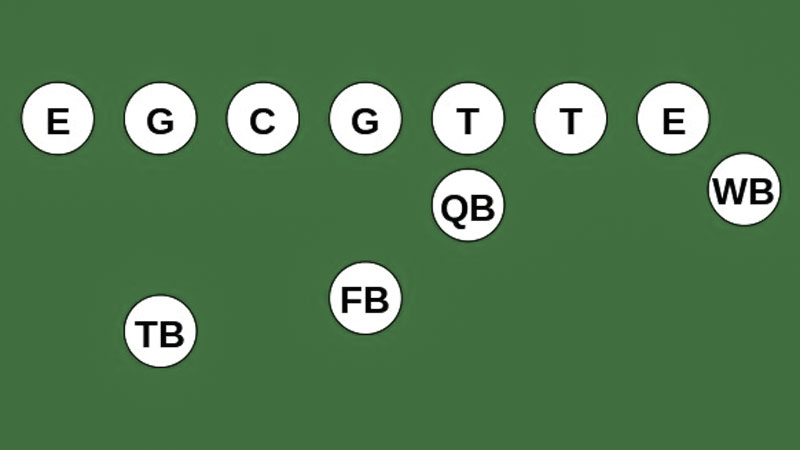In the early 20th century, a revolutionary football formation took the field, forever changing the game. Known as the single wing, this strategic setup was masterminded by Glenn “Pop” Warner in 1907 while coaching the Carlisle Indians.
With the legendary Jim Thorpe at his disposal, Warner crafted an offense that maximized Thorpe’s versatility to run, pass, and punt.
The single wing formation, initially called the Carlisle Formation, gained its name because it resembled the shape of a wing. This formation became a staple in college football, dominating the sport until the 1940s.
Its unique positioning and play-calling flexibility made it a formidable offensive strategy, allowing teams to exploit defensive weaknesses with a mix of power and finesse. Today, the single wing remains a fascinating chapter in the evolution of American football tactics.
Evolution of the Single Wing Formation
The single wing formation’s impact on football tactics is profound, with its dynamic adaptation over time shaping offensive strategies.
Origins and Early Development
Glenn “Pop” Warner devised the single wing in 1907 at Carlisle Indian Industrial School. The formation’s versatility enabled players like Jim Thorpe to perform multiple roles, enhancing offensive unpredictability.
Initially known as the Carlisle Formation, this setup dynamically used unbalanced lines and direct snaps to exploit defensive weaknesses.
Key Innovators and Teams
Several coaches and teams have significantly impacted the single wing’s evolution. Coach Harold “Tubby” Raymond popularized the Wing-T offense at the University of Delaware, winning three National Championships.
Coach Dimperio’s deceptive single wing strategy led to impressive victories, illustrating its effectiveness against heavier teams.
In Connecticut, Anthony Sagnella’s North Haven High School team reached the 2015 Class L State Championship using the single wing, showcasing the formation’s enduring success.
Characteristics of the Single Wing Formation
The single wing formation, though less common today, still influences modern football tactics. This formation’s characteristics are reflected in various offensive strategies and player roles.
Offensive Strategies
The single wing formation employs various offensive strategies, such as pulling guards to create gaps, double teams to overpower key defenders, and play action passes to deceive defenses.
It also uses laterals for quick ball movement, wedge and trap blocking for protection and openings, and unpredictable plays like the sweep and reverse. Additionally, a quick kick can catch the defense off guard, often resulting in favorable field position.
Roles and Responsibilities Within the Formation
Player roles in the single wing formation are distinct. The quarterback, positioned near the line of scrimmage, handles the ball and makes critical decisions. Other backs, like the fullback and wingback, stay near the line to exploit gaps.
Pulling guards move laterally to block defenders, aiding running plays. The tight end acts as both a blocker and receiver, adding versatility. While wide receivers weren’t part of the traditional single wing, they now spread the defense and offer receiving options.
The Decline and Evolution
The single wing formation had a significant impact on football tactics but has seen changes in popularity and usage over the years.
Shift to More Popular Formations
Mid-20th-century football saw a shift from the single wing to formations like the T formation and the I formation. The T formation, introduced by Clark Shaughnessy and popularized by the Chicago Bears, had a direct impact on the single wing’s decline.
Its balanced line and quarterback under the center allowed for more diverse plays and easier passing options. NFL teams favored these formations because they utilized an efficient, straightforward design, making them easier to coach and execute.
Contemporary Use in Specific Scenarios
Although the single wing isn’t common in modern professional football, it remains valuable in certain contexts.
High school teams, like North Haven High School, use the single wing to gain strategic advantages, particularly against stronger opponents, due to its deceptive plays and power running.
In goal-line situations and short-yardage plays, coaches use single wing concepts for their unpredictability and blocking strength, keeping it relevant in contemporary playbooks and adding complexity to offensive strategies.
Notable Teams and Coaches
Let’s highlight some notable teams and coaches who have made significant contributions to the single wing formation:
Historical Significance
Several teams and coaches have influenced the single wing’s development and legacy. Glenn “Pop” Warner’s innovations at Carlisle Indian Industrial School in 1907 laid the groundwork for this formation.
Warner’s system enhanced deception and power running, dominating early 20th-century football. The Pittsburgh Panthers, under Coach Jock Sutherland, used a precise double-wing attack, known as the Sutherland Scythe, which contributed to their national prominence.
Modern Advocates of the Single Wing
In modern times, the single wing has seen renewed interest from coaches looking for versatile offensive strategies. Tim Tebow’s tenure with the Denver Broncos showcased the formation’s adaptability, as the team included elements that allowed for diverse play options.
High school programs, such as North Haven High School, have also enjoyed success with the single wing. Guided by Coach Anthony Sagnella, North Haven secured the 2015 Class L State Championship using this formation.
The single wing’s ability to deceive defenses and create mismatches remains appealing to teams seeking unique strategic benefits.
Frequently Asked Questions
Who invented the single wing formation?
The single wing formation was invented by Glenn “Pop” Warner in 1907 at the Carlisle Indian Industrial School.
What is the single wing formation in football?
The single wing is an offensive football formation where the snap is tossed rather than handed, typically including one wingback. It was a precursor to the modern spread or shotgun formation.
Why did the single wing lose popularity?
The single wing lost popularity due to the rise of new formations like the T formation and I formation, which were seen as more versatile and easier to implement.
How has the single wing evolved over time?
Innovators like Coach Harold “Tubby” Raymond and Coach Dimperio have evolved the single wing, adapting it to modern strategies and making it effective in high school football today.
Which teams have found success with the single wing?
Teams such as North Haven High School have achieved success with the single wing, notably winning the 2015 Class L State Championship under Coach Anthony Sagnella.
Conclusion
The single wing formation’s rich history and strategic depth make it a fascinating subject in American football. From its inception by Glenn “Pop” Warner to its modern-day applications, this formation has shown remarkable resilience and adaptability.
Coaches and teams continue to leverage its unique advantages, proving that old tactics can still find success on today’s gridiron. Whether it’s high school teams or notable figures like Tim Tebow, the single wing remains a testament to innovation and tactical ingenuity in football.
Whether it’s high school teams or notable figures like Tim Tebow, the single wing remains a testament to innovation and tactical ingenuity in football. Its focus on misdirection, power running, and flexible alignment offers modern coaches a versatile playbook.
As football evolves, the single wing formation continues to influence new offensive strategies, blending tradition with contemporary tactics.








Ashley Hopkinson